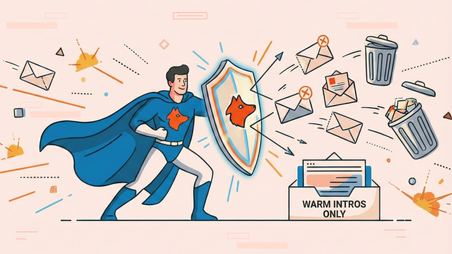A Cold Email Outreach Guide for Recruiters

Generic cold emails that look like hundreds of other outreach messages won’t help recruiters acquire the best talent. Candidates are more likely to ignore such messages and respond to an email that stands out and makes a memorable first impression.
So, how can you make your email personalized and informative enough to grab the attention of a prospect who doesn’t know anything about your organization?
We’ve compiled a list of tips from professional recruiters that will help you attract passive candidates.
1. Remember that you’re reaching out to a real person
Time is a non-renewable resource so remember that you’re trying to contact a real person with their own lives and experiences. Respecting the candidate’s time and making recipients feel special and valued is crucial.
Respect the candidate’s time
You may want to enrich your cold email with a lot of extra information to describe your company in detail, but remember that recipients might not have enough time to read such an essay.
Your main goal here is to motivate a candidate to read your message and consider your offer.
Here’s an example of information you can include in your initial outreach email:
- Clarify the reason for reaching out
- Add links to your company’s website and the job description
- Provide a brief list of duties
- Mention the salary range
- Include a clear CTA (e.g., “Schedule a call)
Address them by their name
It may seem that addressing a candidate by name is just a polite gesture, but it shows them that your message is not just another bulk email you sent to your entire contact base.
You don’t need to do it manually, as most email template builders enable you to address recipients by name with the help of merge tags. You can also use a cold email automation tool to personalize your emails at scale.
2. Do your homework
You don’t want your email to look like another spammy message from someone who didn’t even learn anything about the candidate’s skills, career goals, and background before reaching out.
Here are some ways to show recipients that you value their time and put some effort into your research:
Ask the team you’re recruiting for about the pros and peculiarities of the project and position
You will need to compile a detailed list of peculiarities of the project to warn candidates about everything that isn’t common for their new position.
For instance, it may require frequent business trips, so it won’t make sense to contact a person who wants to work from home.
Learn the candidate’s experience
Try to learn more about your candidate’s professional experience by going beyond their LinkedIn profile.
For example, content writers publish their articles on Medium, web designers post their portfolios on Behance, developers showcase their past projects on GitHub, etc.
3. Make your subject line concise and meaningful
It doesn’t matter how personalized and informative your email body is if your message is never opened.
We recommend you limit your subject line’s length to 36-50 characters.
Longer subject lines may get clipped, especially if recipients view their inboxes on smartphones, so it’s vital to make your copy short yet meaningful and attention-grabbing.
Here are some examples of succinct and informative subject lines you can use:
- New developer opportunity for [Recipient Name]
- Email marketer needed in [City Name]
- Referred to you by [Connection Name]
- I was impressed by your recent blog post
- $1xx,000 career opportunity
- Looking for a pro writer, I found you, [Recipient Name]
- Amazing career opportunity for [Recipient Name] at [Company Name]
4. Work on the content of your message
Now that you’ve motivated recipients to open your message, it’s time to create a brief and informative email body. We’ve handpicked some tips to make candidates reply to your cold emails:
Write a short introduction
Explain why you’re reaching out and describe your organization in a few sentences. You can also provide a link to your company’s website and the job description.
During this stage, there’s no need to get into the position’s specifics or write lengthy paragraphs about the company — you can do this during the job interview.
Here’s an example of a concise yet informative introduction:
“Hi [Recipient Name]! I am [Your Name] at [Company Name]. Our company is currently looking for [Position] to join our dedicated team. I have come across your portfolio on Behance, and your design skills are impressive.”
Provide a short list of duties
There’s no need to overload people with the entire list of duties or a detailed description of a typical workday at this stage. You can also use a bulleted list to make your email more structured.
Mention the salary range
Let’s be honest — a competitive salary is important. Besides compensation, there are also lots of benefits to negotiate, like a flexible work schedule, paid time off, and health insurance, but the candidate still needs to know if the salary your company can pay is attractive enough to leave their current workplace.
Proofread your email
Typos happen to the best of us, so don’t forget to proofread your email. Here are some tips to make your message look professional:
- Verify your recipient’s name and email address
- Check the links and attached files
- Make sure your text conveys a straightforward message
- Avoid filler words and phrases
- Make sure your email is free of grammatical and spelling errors
5. Send your email at the right time
Sending your email at the right time will boost open rates and improve engagement. Even if you want to offer a candidate their dream job, they may forget about your email before they have time to open it and respond.
We recommend that you send cold emails on Tuesday, Wednesday, and Thursday between 1 to 3 PM or 9 to 11 AM.
Mondays and Fridays are usually packed with meetings, so your candidates may not have enough time to check their inboxes. As a result, people are more likely to open emails faster mid-day and mid-week.
Wrap up
Reaching out to potential employees is a challenging task, but following our recommendations will help you attract more candidates. To recap, here’s what you need to do to get your cold recruiting emails opened:
- Respect the candidate’s time
- Personalize your email
- Learn the candidate’s experience
- Keep your subject line and email body concise and meaningful
- Proofread your email
- Send emails at the right time




 Send cold emails with Hunter
Send cold emails with Hunter